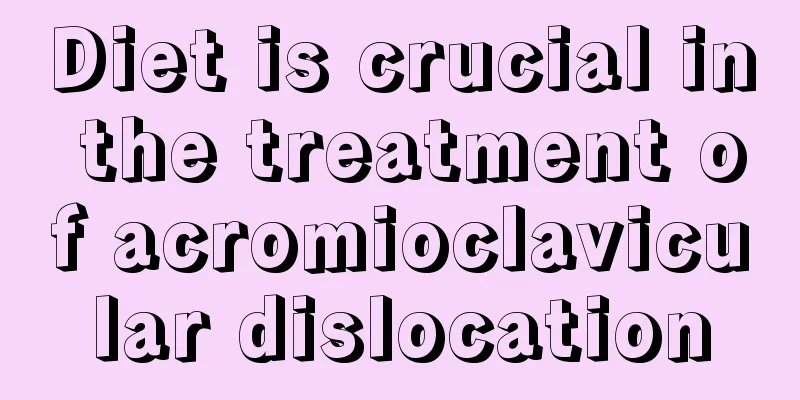Diet is crucial in the treatment of acromioclavicular dislocation

|
Conservative treatment and surgical treatment are currently the two common methods for treating acromioclavicular joint dislocation, and both have very good results. It should be noted that you should pay attention to your diet after the operation, improve your nutrition, eat more protein-rich foods, such as fish, eggs, soy products, etc., and increase calcium appropriately; drink more water, eat more vegetables and fruits, such as green vegetables, celery, bananas, etc. 1. Treatment 1. Conservative treatment For type I acromioclavicular dislocation, rest and sling with a triangular bandage for 1 to 2 weeks is sufficient; for type II dislocation, a sling can be used for fixation. The method is that the patient stands with both upper limbs raised high, and a plaster apron is put on first, with the upper edge at the same level as the nipple plane and the lower edge to slightly below the anterior superior iliac spine. An iron buckle is installed on the front and back of the apron. After the plaster is completely dry, a piece of thick felt is placed on the raised part of the outer end of the clavicle (do not place it on the acromion). Another 3-5 cm wide belt-type canvas belt is used to pass over the thick felt placed on the affected shoulder, and the two ends of the belt are tied to the iron buckles on the front and back of the plaster apron. Tighten it with appropriate force to compress and reposition the separated outer end of the clavicle. Take an X-ray to confirm reduction, wrap the injured limb with a triangular bandage, and fix it for 4 to 6 weeks. It can also be reduced under local anesthesia, with Kirschner wires cross-fixed from the distal end of the clavicle through the acromioclavicular joint and the acromion. The affected limb was suspended after the operation, the steel needle was removed after 6 weeks, and shoulder joint functional exercises were performed. 2. Surgical treatment For patients with total dislocation of the acromioclavicular joint, i.e. type III injury, the joint capsule, acromioclavicular ligament and coracoclavicular ligament have been ruptured, causing the acromioclavicular joint to completely lose stability. The above-mentioned external fixation effect is unsatisfactory. For patients under the age of 45, surgical repair should be performed. Commonly used surgical methods include open reduction and internal fixation of the acromioclavicular joint, reconstruction or fixation of the coracoclavicular ligament, resection of the lateral end of the clavicle, and muscle dynamic reconstruction. (1) Acromioclavicular joint open reduction and Kirschner wire fixation: This method is suitable for patients with type II dislocation. (2) Clavicle resection and coracoclavicular ligament transposition (3) Chronic acromioclavicular dislocation and acromioclavicular subluxation generally have no clinical symptoms and do not require surgical treatment. If there are symptoms such as pain in total dislocation, the following operations can be performed: ① Resection of the outer 1/3 of the clavicle, so that its appearance and function can be satisfactory; ② Transposition of the coracoacromial ligament to replace the coracoclavicular ligament: cut off the scapular end of the coracoacromial ligament, sew this end into the clavicular medullary cavity of the removed end, tighten and ligate; ③ Muscle dynamic transposition: After the acromioclavicular joint is open, reduced and fixed with Kirschner wires, the coracoid process is cut off from its base, and transplanted upward and inward to the clavicle together with the tendon on it, and fixed with screws. The tension of the muscles attached to the coracoid process is used to maintain the position of the clavicle after reduction. 2. Diet and Health Care 1. What foods are good for the body when the acromioclavicular joint is dislocated: Nutrition should be improved, and more protein-rich foods should be eaten, such as fish, eggs, soy products, etc., and calcium should be increased appropriately. Drink more water and eat more vegetables and fruits, such as green vegetables, celery, bananas, etc. 2. What foods should you avoid if you have acromioclavicular joint dislocation: Avoid irritating foods such as chili peppers, mustard, etc. Habits such as smoking and drinking should be given up. |
<<: Can fennel powder and rice vinegar cure body odor? These methods can help you
>>: Are the hazards of eyelash extensions really that serious?
Recommend
What is a hepatitis B virus carrier?
Everyone has heard of hepatitis B and should be f...
Can I smoke while taking Chinese medicine
Taking Chinese medicine to regulate the body is a...
What are the possible symptoms of bladder cancer
Oncologists say that in real life, when many blad...
What is glioma?
Gliomas are a type of brain tumor. Because they a...
Men, have you done prostate cancer screening?
Everyone should know these familiar names, such a...
What is the matter with the white granular protrusions on the tonsils
If there are white millet-like substances on the ...
Cucumber facial mask can remove chloasma
The biggest benefit of applying cucumber on the f...
What are the manifestations of bladder cancer ultrasound examination
Urinary tract tumors often cause painless hematur...
Inguinal hernia symptoms, women suffer more
Hernia is a disease that is mostly related to dev...
What kind of shoes are suitable for women to wear when traveling in summer?
Although the weather is hot in summer, it cannot ...
Prostate cancer surgery methods
Cancer is quite scary for people, after all, it c...
What is the cause of the stabbing pain in the temple
The temple is a very important acupuncture point,...
Eating biscuits and cakes often can cause uterine cancer. Can uterine cancer be prevented?
Most women love to eat sweets, and some female di...
What are the treatments for blood heat?
From the perspective of traditional Chinese medic...
How to treat stiff neck after radiotherapy for nasopharyngeal carcinoma?
How to treat neck stiffness after radiotherapy fo...









